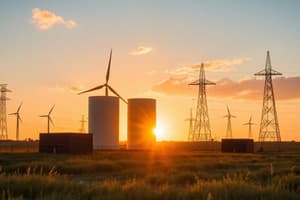Podcast
Questions and Answers
Which type of energy resource is categorized as non-renewable?
Which type of energy resource is categorized as non-renewable?
- Nuclear energy (correct)
- Geothermal reservoirs
- Tidal energy
- Wind energy
What percentage of the global energy demand in 2018 was contributed by renewable energy sources?
What percentage of the global energy demand in 2018 was contributed by renewable energy sources?
- 10%
- 25% (correct)
- 40%
- 7%
Which form of energy is categorized as secondary energy?
Which form of energy is categorized as secondary energy?
- Nuclear fission
- Refined oil products (correct)
- Solar energy
- Wood
Which of the following is NOT classified as a kinetic energy resource?
Which of the following is NOT classified as a kinetic energy resource?
What characterizes non-commercial energy according to the classifications?
What characterizes non-commercial energy according to the classifications?
What primarily contributes to the energy gap experienced by many countries?
What primarily contributes to the energy gap experienced by many countries?
Which of the following statements about energy producers is true?
Which of the following statements about energy producers is true?
What has been a major factor in the widening energy gap in recent years?
What has been a major factor in the widening energy gap in recent years?
Which statement correctly describes global energy consumption patterns?
Which statement correctly describes global energy consumption patterns?
What is a characteristic of fossil fuels?
What is a characteristic of fossil fuels?
Study Notes
Energy Resources
- Fossil Fuels are a significant source of energy, including coal, oil, and natural gas
- Renewable energy sources are replenished naturally, including solar, wind, and hydropower.
- Non-renewable energy sources are finite and deplete over time, with examples being fossil fuels and nuclear sources.
- Depletable energy sources diminish with use, including several non-renewable sources.
- Non-depletable sources are practically inexhaustible, such as solar and wind energy.
Energy Consumption Trends
- Global energy demand is constantly rising,
- Energy consumption increased by 2.3% in 2019.
- Renewable energy sources contributed roughly one quarter of the global energy consumption growth in 2019.
- Nuclear energy contributed roughly 7% of the global energy consumption growth in 2019.
Key Energy Consumers
- Europe and North America consume 70% of the world's energy.
- South America, Africa, and Southeast Asia have lower energy demands.
- Countries with higher energy demands are typically major energy producers.
Energy Gap
- Energy gap refers to the difference between a country's rising energy demand and its ability to meet that demand from domestic resources.
- The energy gap is widening due to the phasing out of fossil fuels and the mismatch between energy consumption and production.
Coal
- India is the third largest producer of coal and relies heavily on it as an energy source.
- Coal is formed from the compression of plant matter over millions of years.
- Different types of coal are classified based on carbon content and time period, such as anthracite, bituminous, and lignite.
Petroleum
- India produces petroleum from Mumbai, Gujarat, and Assam.
- Advantages:
- Easy transport of liquid fuel
- Lighter than coal for air transport
- Diverse by-products
- Economical storage
- Disadvantages:
- Highly evaporable, requiring specialized storage
- Higher production costs than coal
- Contributes to air pollution with pollutants like NO, SO2, CO, and CO2
- Limited reserves compared to coal
Natural Gas
- A cleaner source of energy than coal and oil
- Major Indian reserves are found in the Krishna-Godavari basin, Mumbai High, Gulf of Cambay, and Andaman and Nicobar Islands.
- Primarily composed of methane, with other hydrocarbons like propane, butane, pentane, and hexane also present.
- Commonly used as a fuel and industrial raw material
- Liquefied Petroleum Gas (LPG) is a mixture of butane and propane.
Wind Energy
- Renewable and sustainable source of energy
- Fast electricity generation
- Cheaper than other sources
- Widely available onshore, offshore, and in remote areas
- Disadvantages:
- Limited to specific geographic locations
- Variable and intermittent energy output
- Complex design, manufacture, and installation due to diverse atmospheric conditions
- Requires vast open areas
- Economical only on a small scale
Hydropower Energy
- Utilizes flowing water to generate electricity
- India's hydroelectric power generation capacity is 27,010 MW
- Advantages:
- Extended lifespan
- Minimal operating staff
- Non-polluting and environmentally friendly
- Low cost of generation and maintenance
- Disadvantages:
- Requires extensive land acquisition with potential for submergence
- Involves political, regional, and social hurdles in land acquisition
- Long approval process for hydro-power projects
- Challenges in rehabilitating and resettling displaced communities
- Significant initial investment
Hydrogen Energy
- A combustible gas that releases a significant amount of energy upon combustion
- Clean fuel with minimal pollution
- Challenges:
- Fire and explosion hazards
- Difficult to store and transport
- Large-scale production for commercial use is still in development
- High production costs
- Requires substantial external energy to extract hydrogen from water or coal
- Fuel cells offer a potential solution for storage and transportation
- Abundant water is a readily available raw material for hydrogen production, making it environmentally friendly.
Studying That Suits You
Use AI to generate personalized quizzes and flashcards to suit your learning preferences.
Related Documents
Description
Explore the various sources of energy, including fossil fuels and renewables, and understand their trends in consumption. This quiz also covers key information about global energy demand and the main energy consumers around the world. Test your knowledge on energy resources and their impact on the environment and economy.




